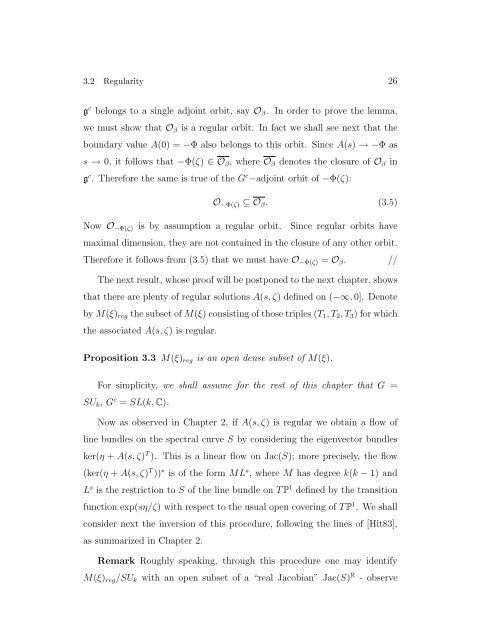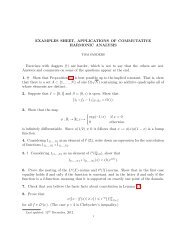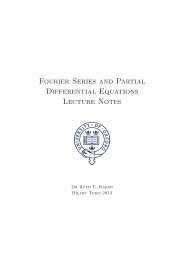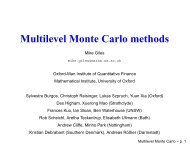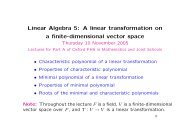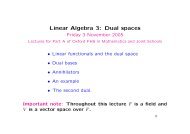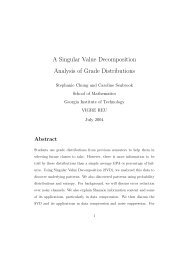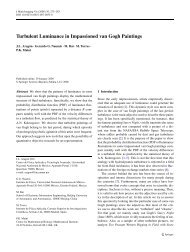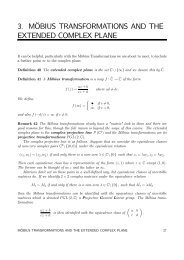Construction of Hyperkähler Metrics for Complex Adjoint Orbits
Construction of Hyperkähler Metrics for Complex Adjoint Orbits
Construction of Hyperkähler Metrics for Complex Adjoint Orbits
You also want an ePaper? Increase the reach of your titles
YUMPU automatically turns print PDFs into web optimized ePapers that Google loves.
3.2 Regularity 26<br />
g c belongs to a single adjoint orbit, say Oβ. In order to prove the lemma,<br />
we must show that Oβ is a regular orbit. In fact we shall see next that the<br />
boundary value A(0) = −Φ also belongs to this orbit. Since A(s) → −Φ as<br />
s → 0, it follows that −Φ(ζ) ∈ Oβ, where Oβ denotes the closure <strong>of</strong> Oβ in<br />
g c . There<strong>for</strong>e the same is true <strong>of</strong> the G c −adjoint orbit <strong>of</strong> −Φ(ζ):<br />
O−Φ(ζ) ⊆ Oβ. (3.5)<br />
Now O−Φ(ζ) is by assumption a regular orbit. Since regular orbits have<br />
maximal dimension, they are not contained in the closure <strong>of</strong> any other orbit.<br />
There<strong>for</strong>e it follows from (3.5) that we must have O−Φ(ζ) = Oβ. //<br />
The next result, whose pro<strong>of</strong> will be postponed to the next chapter, shows<br />
that there are plenty <strong>of</strong> regular solutions A(s, ζ) defined on (−∞, 0]. Denote<br />
by M(ξ)reg the subset <strong>of</strong> M(ξ) consisting <strong>of</strong> those triples (T1, T2, T3) <strong>for</strong> which<br />
the associated A(s, ζ) is regular.<br />
Proposition 3.3 M(ξ)reg is an open dense subset <strong>of</strong> M(ξ).<br />
For simplicity, we shall assume <strong>for</strong> the rest <strong>of</strong> this chapter that G =<br />
SUk, G c = SL(k, C).<br />
Now as observed in Chapter 2, if A(s, ζ) is regular we obtain a flow <strong>of</strong><br />
line bundles on the spectral curve S by considering the eigenvector bundles<br />
ker(η + A(s, ζ) T ). This is a linear flow on Jac(S); more precisely, the flow<br />
(ker(η + A(s, ζ) T )) ∗ is <strong>of</strong> the <strong>for</strong>m ML s , where M has degree k(k − 1) and<br />
L s is the restriction to S <strong>of</strong> the line bundle on T P 1 defined by the transition<br />
function exp(sη/ζ) with respect to the usual open covering <strong>of</strong> T P 1 . We shall<br />
consider next the inversion <strong>of</strong> this procedure, following the lines <strong>of</strong> [Hit83],<br />
as summarized in Chapter 2.<br />
Remark Roughly speaking, through this procedure one may identify<br />
M(ξ)reg/SUk with an open subset <strong>of</strong> a “real Jacobian” Jac(S) R - observe


